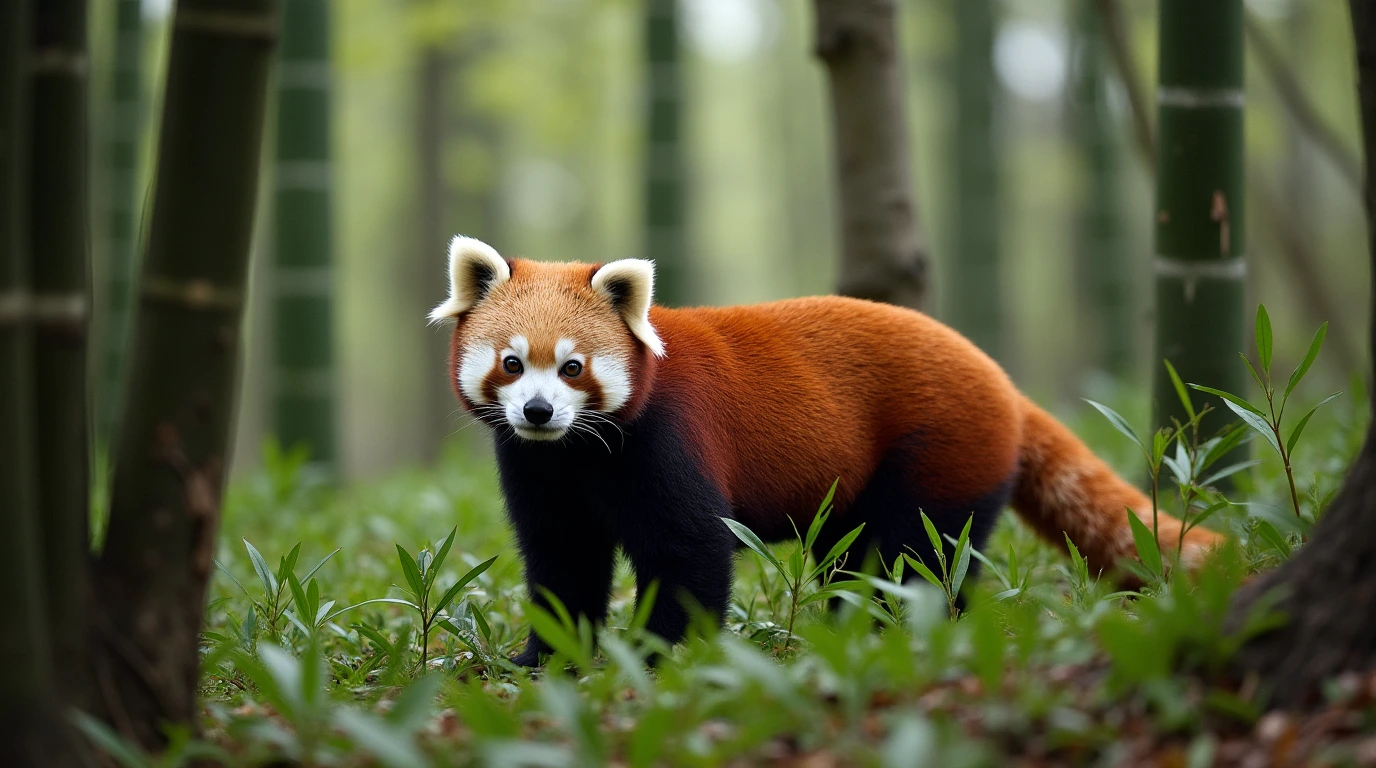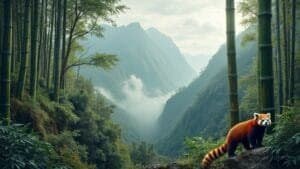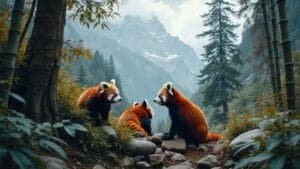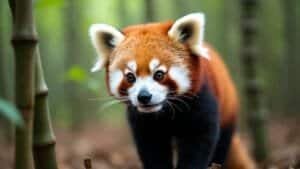Red pandas live in a very specific kind of forest—one that combines altitude, moisture, and plant diversity into the perfect environment for their survival. These mammals are native to the temperate, high-altitude forests of the Eastern Himalayas and parts of southwestern China, where the landscape is dominated by a mix of broadleaf and coniferous trees with a dense bamboo understory. This habitat, rich in both food and shelter, is found between 7,900 and 12,800 feet in elevation and spans countries like Nepal, Bhutan, India, Myanmar, and China
Within these forests, red pandas rely on vertical tree layers for movement and safety, while bamboo forms the core of their diet. The cool, foggy climate keeps the undergrowth lush and edible, maintaining the moisture that bamboo and other key vegetation need. In this article, we’ll explore the types of forests red pandas inhabit, the unique conditions they depend on, and how regional and seasonal variations influence their habitat across their entire range
Forest Habitats Where Red Pandas Live

Red pandas inhabit one of the most ecologically rich and climatically distinct forest types in the world—temperate mountain forests. These environments provide the combination of food, shelter, and safety required for red panda survival. Distributed along the southern slopes of the Himalayas and stretching into the mountainous provinces of southwestern China, these forests are shaped by altitude, seasonal patterns, and a remarkable diversity of plant species
Location and Characteristics of Temperate Forests
The temperate forests red pandas occupy are located primarily within the Eastern Himalayas and parts of China’s Sichuan and Yunnan provinces. These forests are generally found at elevations between 7,900 and 12,800 feet (approximately 2,400 to 3,900 meters). The terrain is rugged, marked by steep slopes, ridgelines, and valleys, which together support microclimates that stay cool and moist throughout the year
These high-elevation forests are rich in biodiversity, often hosting over a thousand species of plants, insects, and other wildlife. This biological richness makes them particularly valuable from an ecological perspective and underscores the importance of preserving these habitats. According to the Red Panda Network, these forests form the core range of red panda populations and are essential not only for foraging and nesting but also for maintaining the broader mountain ecosystem
The forest floor is typically covered with thick mosses, ferns, and bamboo, while the upper canopy layers provide a network of tree branches red pandas use for movement and resting. The vertical stratification of these forests creates safe, elevated zones that red pandas use to avoid predators and disturbances from the ground
Elevation Ranges That Support Red Panda Forests
Red pandas are altitude specialists. They are most commonly found in forest belts located between 7,900 and 12,800 feet above sea level. These elevations provide the cooler temperatures and higher humidity levels that support the types of bamboo they depend on. They also offer some isolation from human development and livestock grazing, which are more common at lower elevations
This elevational band is also important because it forms a climate buffer—temperatures remain mild during summer and cold during winter, but never extreme. This stability helps bamboo thrive and ensures that trees retain their foliage and branching structures, both of which are essential for red panda shelter and movement. The slope and aspect of these elevations also affect microclimates; north-facing slopes may retain snow longer and support slightly different vegetation than sunnier southern slopes, allowing red pandas to adjust their movement patterns seasonally
In countries like Nepal, India, and Bhutan, these forests are primarily concentrated in the middle and upper hill zones. In China, red pandas often inhabit slightly broader elevational ranges due to local climate differences and more extensive forest cover, especially in the provinces of Sichuan and Yunnan, where fog and rain sustain bamboo even at higher altitudes
Role of Bamboo in Red Panda Forest Ecosystems
Bamboo is the defining feature of red panda forest ecosystems. Though these animals are taxonomically carnivores, their diet is almost entirely herbivorous, with bamboo making up around 85–95% of their daily intake. Bamboo species like Yushania and Arundinaria dominate the understory of these forests, forming dense thickets that red pandas use for both feeding and concealment
The presence of bamboo is not just important for nutrition—it also helps shape the movement patterns and territorial boundaries of red pandas. Because bamboo growth can be patchy and seasonal, red pandas often select home ranges based on the density and quality of bamboo patches. Forest areas without bamboo, no matter how structurally sound, are generally avoided
Seasonal changes in bamboo availability also influence red panda behavior. During spring and early summer, red pandas consume tender bamboo shoots, which are more nutritious and easier to digest. As the seasons progress, they shift to eating mature leaves. This dietary reliance means that the health and continuity of bamboo growth are directly tied to red panda survival
In addition, bamboo thickets provide natural cover from aerial and terrestrial predators and protect red pandas from the elements, especially in winter when snow and wind can reduce visibility and increase energy demands. The synergy between bamboo and tree cover is central to the structure and function of red panda habitats and reflects the ecological niche these animals have carved out in some of Asia’s most challenging landscapes
Vegetation and Structure of Red Panda Forests

The forests inhabited by red pandas are among the most structurally complex and botanically diverse in the world. Their combination of tree species, vertical layering, and ground-level vegetation creates a three-dimensional environment perfectly suited to the red panda’s arboreal lifestyle. Every layer of the forest—from the roots of bamboo to the highest canopy branches—plays a role in supporting the needs of this elusive mammal
Tree Species Common in Red Panda Habitat
The trees found in red panda forests vary depending on location, but they generally include a mix of evergreen conifers and broadleaf deciduous species. In the Himalayan regions of Nepal, Bhutan, and India, common tree species include rhododendrons, oaks (Quercus spp.), maples (Acer spp.), and alders (Alnus spp.)
In the Chinese provinces of Sichuan and Yunnan, the forests feature more fir (Abies spp.), hemlock (Tsuga spp.), and spruce (Picea spp.), as well as evergreen broadleaf trees adapted to the slightly more humid subtropical climate
These trees form a dense canopy that shields the forest floor from excessive sunlight, helping to retain the moisture necessary for bamboo to flourish. They also provide essential climbing structures for red pandas, which rely on thick branches and interconnected canopies to move through the forest, find resting spots, and escape predators. The bark and branches of these trees often host mosses, lichens, and epiphytes, adding another layer of microhabitat diversity and contributing to the forest’s year-round humidity
Forest Structure Supporting Arboreal Behavior
Red pandas are arboreal animals, meaning their survival strategies are heavily dependent on the physical structure of the forest. The forests they inhabit are multi-layered, with a well-developed understory dominated by bamboo, a midstory of shrubs and saplings, and a tall canopy formed by mature trees. This vertical structure is essential for providing safe passage, thermal regulation, and concealment from predators
The upper branches of trees serve as sleeping and resting sites during the day. Red pandas typically select high, horizontal limbs where they can stretch out or curl into a tight ball, often with their tail wrapped around their body to conserve heat. They also make use of tree hollows, particularly in older, larger trees that offer protection from wind and snow
Because red pandas rarely descend to the ground unless necessary, the ability to move horizontally through the canopy is critical. The forest’s connectivity—how well tree crowns overlap and how dense the foliage is—directly influences red panda movement patterns and habitat suitability. Forests that are logged or fragmented often lose this vertical integrity, making them less hospitable even if bamboo is still present
Climate Conditions in Red Panda Mountain Forests
The climatic conditions of red panda habitats are defined by their elevation and geography. These forests typically experience a cool, moist, and foggy climate throughout the year. Temperatures generally range between 50°F and 75°F (10°C to 24°C), with seasonal snowfall in winter and high rainfall during the summer monsoon
Humidity remains high due to frequent fog and cloud cover, which is especially common in the eastern Himalayas and western China. This moisture helps support both the bamboo understory and the epiphytic plants growing on trees. The combination of rain, snowmelt, and mist creates a uniquely stable and lush environment in which vegetation thrives
These consistent moisture levels are vital for bamboo, which is sensitive to drought and temperature extremes. Forests at this elevation also tend to retain water longer due to cooler temperatures, further supporting the dense vegetation needed for red panda survival. The constant presence of water also benefits other wildlife and plants, reinforcing the importance of these mountain forests as ecological hotspots
Regional Differences in Red Panda Forests

While red pandas across their range occupy similar types of temperate forests, there are important regional variations in forest composition, climate, and vegetation structure. These differences reflect both ecological diversity and the specific adaptations of the red panda populations that inhabit each area. From the steep ridges of the Eastern Himalayas to the subtropical highlands of China, each forest region offers a distinct version of the red panda’s essential habitat
Himalayan vs. Chinese Forest Composition
In the Himalayan portions of their range—spanning Nepal, Bhutan, northeastern India, and northern Myanmar—red panda forests are typically cooler and more seasonal. These forests are often dominated by deciduous broadleaf species like oak, maple, and birch, along with a strong presence of rhododendrons and occasional conifers such as fir. The bamboo understory here is interspersed among dense stands of mixed-age trees, providing both food and shelter in close proximity
In contrast, the forests of southwestern China, particularly in Sichuan and Yunnan, have a greater abundance of evergreen trees and a higher annual humidity due to monsoon influence. These forests support more coniferous species, such as hemlock and spruce, and tend to be denser with taller canopies. Bamboo is often more uniformly distributed in these Chinese forests, supporting the larger-bodied Chinese red panda (Ailurus fulgens styani), which is distinct from its Himalayan counterpart in both appearance and habitat preference
These compositional differences affect not just the species of plants and trees but also the types of microhabitats available, the seasonal availability of bamboo shoots, and the structure of nesting and sleeping sites. Regional adaptation to these conditions is evident in the foraging behavior and movement patterns of red pandas within each forest zone
Seasonal and Climatic Variability Across the Range
The seasonal conditions in red panda forests vary significantly by region and elevation. In the Himalayas, red pandas endure cold winters with snow accumulation, which can limit food availability and drive changes in activity levels. During these months, red pandas rely on evergreen bamboo leaves and well-sheltered tree sites for survival. Summer brings rain and an abundance of fresh bamboo shoots, berries, and insects, allowing for increased foraging and movement
In the forests of China, while winters can also be cold, the climate tends to be more temperate and humid year-round. These conditions allow for more consistent bamboo growth and less pronounced seasonal variation in food supply. Fog and mist are common, especially in mountainous basins and valleys, providing steady moisture that supports continuous vegetation growth
This climatic stability contributes to a slightly different ecological rhythm for Chinese red pandas, which may show less seasonal reduction in activity compared to their Himalayan relatives. These differences highlight the need for region-specific conservation strategies that consider local environmental pressures, resource availability, and habitat dynamics
Conservation Implications of Forest Diversity
The variability in red panda forests across their range carries significant implications for conservation. Each forest type—whether it’s a deciduous-dominated ridge in Bhutan or a coniferous basin in Sichuan—supports unique plant communities, hydrological systems, and microclimates. Conservation efforts must take these differences into account to be effective
In fragmented or degraded habitats, red pandas face particular challenges in finding the structural and nutritional resources they need. Restoring forest diversity and connectivity in these areas is essential. Conservationists must prioritize reforestation using native tree and bamboo species that match the original forest composition, rather than introducing monocultures or generalized vegetation
Efforts by organizations such as the Red Panda Network focus on protecting these unique habitats by working with local communities to promote sustainable forestry practices and create wildlife corridors. Protecting the regional forest types red pandas depend on ensures not only their survival but also the preservation of the broader ecosystems they help sustain












